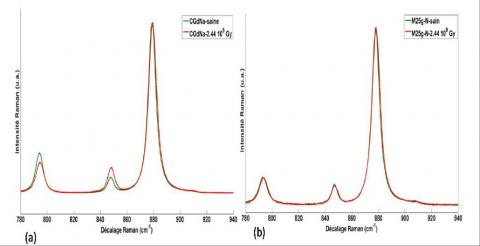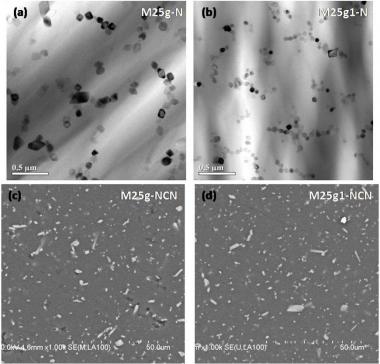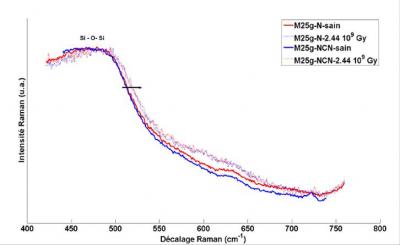


|
The confinement of high activity nuclear wastes requires their storage in safe and sustainable conditions. For this purpose, vitroceramic structures, which are both vitreous and crystalline, have been proposed, since they can have good performances by trapping radioactive elements in the crystalline phase. However, the confinement in such alumino-borosilicate nuclear glasses of molybdenum rich wastes (issued from the graphite-gas line of nuclear power plants) , raises the problem of their devitrification, affecting their confinement properties. Thus, at high concentration of molybdenum or when the loading rate is high, molybdate phases crystallize, and the control of the nature of these precipitates, by the choice of the compositions and of the synthesis processes, is essential for an effective control of the confinement properties of the glass. The study by a team of LSI of model materials of the vitrocristalline structure, shows that the presence of a CaMoO4 phase (Powellite) does not alter the structural evolution of the glassy phase under electronic excitations. |
This work is the subject of the PhD thesis of Tatiana Taurines [1-4],. defended in November 2012. The objective was to understand the influence of irradiation in molybdenum rich ceramic matrices for the containment of high activity nuclear wastes. The study was focused on the interactions between the CaMoO4crystalline phase (powellite [i]) and the glassy phase, with and without irradiation.
The study was conducted on a material model of biphasic ceramic matrices. To perform a well-defined study, it was at first necessary to have models of vitrocristalline materials containing only the powellite phase and a constant residual glass. The influence of various parameters, like the crystallite size and their volume distribution must also be taken into account. Composition and heat treatment must therefore be optimized to obtain a material with a uniform crystal distribution and a constant residual glass composition for all samples. The composition was chosen from a nuclear simplified alumino-borosilicate glass, enriched in molybdenum oxide. Rare earths such as gadolinium, neodymium or europium are added so to simulate the presence of trivalent actinides and as spectroscopic probes.

Evolution of the Raman spectra in the region of the main peaks associated to the powellite phase after electron irradiation of 2.44 x 109 Gy. (a) Powellite ceramic doped with Gd3+ and Na+ ions .(B) Glass ceramic containing 2.5 mol% of MoO3 obtained after the heat treatment for nucleation of the powellite phase. Both spectra are normalized to the most intense line.
Several heat treatments were considered to obtain a material being a well-controlled model of the two-phase microstructure for this complex system. Transmission Electron Microscopy pictures obtained within CIMEX (Ecole Polytechnique) can accurately track microstructure (size, size dispersion, concentration) of the powellite phase (see Figure 1). The heat treatment (N: 110 h at 820 ° C) for nucleation of the crystallites allows obtaining precipitate of bi-pyramidal powellite crystals, with a controlled size between 10 to 250 nm, as a function of the chemical composition. To increase the size of the crystallites, a complex sequence of nucleation and growth heat treatments (NCN) is used. With this method, we obtain powellite crystals with a size up to ten microns. After this treatment, a second population of powellite crystallites remains, with a size of the order of ten nanometers.
To determine the influence of the size and concentration of CaMoO4 powellite precipitates on the structural evolution of the glass under electron excitation, tests of irradiation were performed on different material models with the electron accelerator SIRIUS, with doses up to 2.44 x 109 Gy (1 Gy = 1J/kg). For the powellite phase, no structural changes under electron excitation can be identified by Raman spectroscopy, as shown in the adjacent figure. Powellite phase is thus insensitive to the electronic excitation in this dose range, which is the dose that the matrix will undergo during the confinement period.
Raman spectroscopy can also monitor the structural changes of the glassy phase during irradiation. For example, we observe a shift of +10 cm-1 of the Raman line at 480 cm-1 (Fig. 3) that can be associated with a decrease in the average angle Si-O-Si in the irradiated samples. This phenomenon is similarly observed for non-crystallized glasses. The production of molecular oxygen can be also correlated to an increase of the polymerization of the glass under electron excitation for the various vitro crystalline materials, like for the reference glassy materials.
This study on model ceramics thus shows that the presence of a precipitated powellite phase does not change the structural evolution of the glassy phase regardless the size and concentration of the powellite. This validates the interest in this type of material for the containment of molybdenum-rich wastes.
[1-4] References:
[1] T. Taurines. Étude de vitrocéramiques modèles riches en CaMoO4 pour le confinement de déchets nucléaires. Thèse de doctorat, École Polytechnique, 2012.
[2] Microstructure of powellite-rich glass-ceramics: a model system for high level waste immobilization.
T. Taurines, B. Boizot, Journal of American Ceramic Society 95 (3) (2012) 1105.
[3] Synthesis of powellite-rich glasses for High Level Waste immobilization.
T. Taurines, B. Boizot, Journal of Non Crystalline Solids 357 (2011) 2723.
[4] Powellite-rich glass-ceramics: a spectroscopy study by EPR and Raman spectroscopy
T. Taurines, D. Neff, B. Boizot, , submitted to Journal of American Ceramic Society (2013).
Contacts: B. Boizot et T. Taurines.
• › Caractérisation de matériaux pour l'énergie / Characterization of materials for energy
•  Institut Rayonnement Matière de Saclay • UMR 7642 Laboratoire des Solides Irradiés (LSI)
Institut Rayonnement Matière de Saclay • UMR 7642 Laboratoire des Solides Irradiés (LSI)













